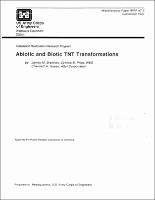Please use this identifier to cite or link to this item:
https://hdl.handle.net/11681/7765| Title: | Abiotic and biotic TNT transformations |
| Authors: | Installation Restoration Research Program (U.S.) Brannon, James M. Price, Cynthia B. Hayes, Charolett A. |
| Keywords: | Abiotic Biotic TNT Soil contamination Soil pollution Groundwater contamination Groundwater pollution Soil remediation Ferrous iron reduction Kinetics Chemistry Transformation products |
| Publisher: | Environmental Laboratory (U.S.) Engineer Research and Development Center (U.S.) |
| Description: | Miscellaneous Paper Abstract: Cleanup of soils and groundwater contaminated with the explosive TNT is a major concern. Interpretation of fate processes, especially equilibrium partitioning, is confounded by the ready transformation of TNT to mono and diamino products. The objectives of this study were to demonstrate the presence of the Fe⁺² abiotic reduction pathway in soils, investigate the pH dependence of the process, and investigate the relationship between aerobic TNT transformations and soil components. Effects of pH on abiotic transformations of TNT were examined in buffered batch tests with montmorillonite and Fe⁺². Results indicated that TNT was rapidly reduced to monoamino transformation products under abiotic conditions, with the rate of reduction increasing as pH increased. Recoveries of unlabled TNT and transformation products ranged from 30 to 50 percent, but radioisotope tests showed complete recovery of 14-C, indicating that significant quantities of unextractable or unknown transformation products were produced. Until these transformation products are identified, mass balances for TNT will not be possible, even in simple environmental systems without the use of 14-C. Suppression of the abiotic Fe⁺² reduction mechanism in anaerobic soil by complexing Fe⁺² with EDTA was short-term, lasting for only an hour before other mechanisms acted to reduce TNT to monoamino and diamino compounds. However, the abiotic Fe⁺² reduction pathway accelerated the initial rate of TNT reduction in anaerobic soil. Suppression of either the abiotic or biotic mechanisms will lower the rate of TNT reduction. Recoveries of added TNT were inversely related to oxalate extractable manganese, percent organic matter, and extractable total axes compounds in aerobic soil. This indicates that the nature of soils, in addition to environmental conditions, will impact TNT fate and transport. |
| Rights: | Approved for public release; distribution is unlimited. |
| URI: | http://hdl.handle.net/11681/7765 |
| Appears in Collections: | Miscellaneous Paper |
